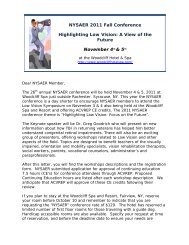Association for Education and Rehabilitation of the ... - AER Online
Association for Education and Rehabilitation of the ... - AER Online
Association for Education and Rehabilitation of the ... - AER Online
You also want an ePaper? Increase the reach of your titles
YUMPU automatically turns print PDFs into web optimized ePapers that Google loves.
Assessment Reliability <strong>and</strong> Fidelity<br />
Table 1. Assessment <strong>of</strong> Individuals Who Are Deaf-Blind <strong>and</strong>/or Have Multiple Disabilities a<br />
Biobehavioral State<br />
What is <strong>the</strong> individual’s current state?<br />
Is <strong>the</strong> individual able to control or modulate his or her state?<br />
How much time does <strong>the</strong> individual spend in an alert state?<br />
What range <strong>of</strong> states does <strong>the</strong> individual show <strong>and</strong> what is <strong>the</strong> transition pattern between states?<br />
What variables affect <strong>the</strong> individual’s state?<br />
Orienting Response<br />
What factors elicit an orienting response?<br />
How does <strong>the</strong> individual exhibit an orienting response?<br />
What sensory channels appear to be associated with an orienting response (sensory in<strong>for</strong>mation that<br />
triggers <strong>the</strong> response <strong>and</strong> <strong>the</strong> senses <strong>the</strong> individual uses)?<br />
Learning Channels<br />
How does <strong>the</strong> individual appear to take in in<strong>for</strong>mation?<br />
How does <strong>the</strong> individual react to sound?<br />
How does <strong>the</strong> individual react to vision?<br />
How does <strong>the</strong> individual react to touch?<br />
Does <strong>the</strong> individual use more than one sense at a time?<br />
Does <strong>the</strong> individual exhibit engagement or disengagement cues in response to particular sensory<br />
in<strong>for</strong>mation?<br />
Approach-Withdrawal<br />
What are <strong>the</strong> individual’s engagement cues?<br />
What are <strong>the</strong> individual’s disengagement cues?<br />
What appears to motivate <strong>the</strong> individual?<br />
What does <strong>the</strong> individual seem to turn away from?<br />
Memory<br />
Does <strong>the</strong> individual habituate to familiar stimuli?<br />
How long or how many presentations <strong>of</strong> stimuli are necessary be<strong>for</strong>e <strong>the</strong>re is habituation?<br />
Does <strong>the</strong> individual attend again if <strong>the</strong> features <strong>of</strong> <strong>the</strong> stimulus change?<br />
Are reactions differentiated?<br />
Does <strong>the</strong> individual react differently to familiar <strong>and</strong> unfamiliar people?<br />
Does <strong>the</strong> individual appear to have object permanence (underst<strong>and</strong>s that something still exists even if it<br />
is not currently visible)?<br />
Does <strong>the</strong> individual associate a preceding event with one that follows?<br />
Does <strong>the</strong> individual appear to anticipate an upcoming event?<br />
Does <strong>the</strong> individual react when <strong>the</strong>re is a mismatch to expectations?<br />
Does <strong>the</strong> individual demonstrate functional use <strong>of</strong> objects?<br />
Is <strong>the</strong> individual able to learn a simple routine?<br />
Is <strong>the</strong> routine learned, remembered?<br />
Interactions<br />
Does <strong>the</strong> individual orient to a person?<br />
Does <strong>the</strong> individual exhibit secure attachment with important individuals in his/her life?<br />
Does <strong>the</strong> individual engage in turn-taking when he or she begins <strong>the</strong> interaction?<br />
How many turns are taken be<strong>for</strong>e disengagement?<br />
In response to partner’s interaction, does <strong>the</strong> individual add more to turn-taking interaction?<br />
a Reproduced with permission from Nelson, van Dijk, McDonnell, et al. (2002).<br />
74 | <strong>AER</strong> Journal: Research <strong>and</strong> Practice in Visual Impairment <strong>and</strong> Blindness







